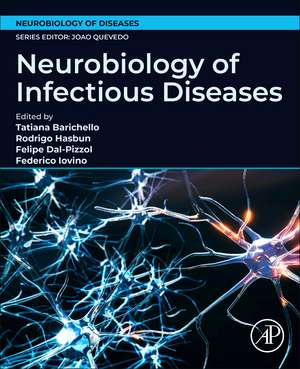Neurobiology of Infectious Diseases: Neurobiology of Disease, cartea 1
Editat de Tatiana Barichello, Felipe Dal-Pizzol, Rodrigo Hasbunen Limba Engleză Paperback – 6 dec 2024
- Reviews the role and function of specialized Blood-Neuronal Barriers
- Covers various forms of brain infections, encephalitis, and meningitis
- Features content on SARS-Cov-2 and CNS, including pathogenesis to clinical manifestation
Preț: 1406.20 lei
Preț vechi: 1480.25 lei
-5% Nou
Puncte Express: 2109
Preț estimativ în valută:
269.16€ • 292.47$ • 226.24£
269.16€ • 292.47$ • 226.24£
Carte indisponibilă temporar
Doresc să fiu notificat când acest titlu va fi disponibil:
Se trimite...
Preluare comenzi: 021 569.72.76
Specificații
ISBN-13: 9780443191305
ISBN-10: 0443191301
Pagini: 622
Dimensiuni: 216 x 276 mm
Greutate: 0.45 kg
Editura: ELSEVIER SCIENCE
Seria Neurobiology of Disease
ISBN-10: 0443191301
Pagini: 622
Dimensiuni: 216 x 276 mm
Greutate: 0.45 kg
Editura: ELSEVIER SCIENCE
Seria Neurobiology of Disease
Cuprins
Part I - Foundations of Neuroinfection 1. Anatomical Organization of central nervous system (CNS) 2. The enteric nervous system’s (ENS) impact on the neurobiology of infectious diseases 3. The role of the microbiota-gut-brain axis on the neurobiology of infectious diseases 4. The role and function of specialized blood-neuronal barriers: Blood-CSF, blood-retinal, blood-spinal cord, blood-labyrinth, blood-nerve barriers, and blood-brain barrier (BBB) 5. Neuroimmune interactions in the neurobiology of infectious diseases 6. The routes and mechanisms of microbial translocation to the central nervous system Part II - Bacterial Infections Of CNS 7. Brain infections, encephalitis, and meningitis: Streptococcus pneumoniae 8. Brain infections, encephalitis, and meningitis: Neisseria meningitidis 9. Brain infections, encephalitis, and meningitis: Streptococcus agalactiae 10. Brain infections, encephalitis, and meningitis: Mycobacterium tuberculosis 11. Neurosyphilis 12. Brain infections, encephalitis, and meningitis: Lyme disease - Lyme borreliosis 13. Brain infections, encephalitis, and meningitis: Brucelosis 14. Brain infections, encephalitis, and meningitis: Listeria monocytogenesis - Listeriosis 15. Sepsis-associated encephalopathy: Understanding the brain dysfunction in sepsis Part III - Parasitic Infections Of CNS 16. African trypanosomiasis: Comprehending the parasite pathogenesis in the brain 17. Cerebral malaria: Understanding the parasite pathogenesis in the brain 18. Neurocysticercosis 19. Free-living amoebae: Pathogens and the central nervous system (CNS) disease 20. Pathophysiological mechanisms of Toxoplasma gondii infection in the central nervous system (CNS) Part IV - Virus Infections Of CNS 21. HIV-infected human brain: Implications in HIV infection and immune response 22. SARS-CoV-2 and nervous system: From pathogenesis of disease to clinical manifestations 23. The neurobiology of herpes simplex virus infection 24. Zika virus: Infection of the central nervous system (CNS) 25. Dengue fever and its neurological complications 26. Japanese encephalitis 27. West Nile viruses: Infection of the central nervous system (CNS) 28. Tick-borne encephalitis (TBE) 29. Chikungunya virus: Infection of the central nervous system Part V– Fungal Infections Of CNS 30. Brain infections, encephalitis, and meningitis: Cryptococcus sp. 31. Central nervous system infection due to Histoplasma capsulatum 32. Brain infections, encephalitis, and meningitis: Coccidioides sp. 33. Brain infections, encephalitis, and meningitis: Candida sp. Part VI – Proteins and other peripheral mediators that affect the CNS 34. Overview of human transmissible spongiform encephalopathies 35. Prion-like proteins in health and disease 36. Autoimmune encephalitis 37. Encephalitis: from mechanisms to management
